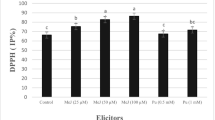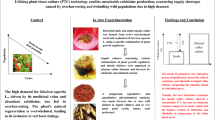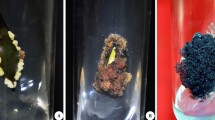Abstract
Licorice (Glycyrrhiza glabra L.), Fabaceae, has a wide range of medicinal properties due to the metabolites found in the plant tissues. Callus cultures from Glycyrrhiza glabra were previously initiated in vitro using leaf as an explant and the current study was designed to examine the possible role of various elicitors (biotin, adenine sulphate, salicylic acid, putrescine, spermine, or spermidine) at different concentrations (25, 50, 75, and 100 mg L−1) on the stimulation of biomass and their effects on the content of different metabolites such as total carbohydrates, protein, proline, phenol, alkaloids, flavonoids, and glycyrrhizin. Elicitation with different concentrations of elicitors increased the biomass and metabolite content in callus culture of G. glabra at different rates. The optimum concentration of adenine sulphate for maximum biomass accumulation (16.79 g flask−1) was found to be at 50 mg L−1 after incubation for 20 d. Adenine sulphate and putrescine were also found to stimulate the metabolite content to 3- to fourfold in the callus cultures as compared to that of control showing that metabolite content and antioxidant enzyme of Glycyrrhiza glabra can be enhanced by appropriate elicitation.
Similar content being viewed by others
References
Abrahamian P, Kantharajah A (2011) Effect of vitamins on in vitro organogenesis of plant. Amer J Plant Sci 2:669–674
Ahmad Z, Shahzad A, Sharma S (2017) Enhanced multiplication and improved ex vitro acclimatization of Decalepis arayalpathra. Biol Plant 1:1–10
Ahmed SA, Mushtaq M, Baig V (2014) Biotic elicitor enhanced production of psoralen in suspension cultures of Psoralea corylifolia L. Saudi J Biologic Sci 21:499–504
Akram M, Aftab F (2015) Effect of cytokinins on in vitro seed germination and changes in chlorophyll and soluble protein contents of Teak (Tectona grandis L.). Biochem Physiol 4:166–172
Alban C, Job D, Douce R (2000) Biotin metabolism in plants. Annu Rev Plant Physiol 51:17–47
Ali MB, Yu KW, Hahn EJ, Paek KY (2006) Methyl jasmonate and salicylic acid elicitation induces ginsenosides accumulation, enzymatic and non-enzymatic antioxidant in suspension culture Panax ginseng roots in bioreactors. Plant Cell Rep 25:613–620
Asthir B, Koundal A, Bains NS (2012) Putrescine modulates antioxidant defense response in wheat under high temperature stress. Biol Plant 56:757–761
Aydin M, Pour AH, Haliloğlu K, Tosun M (2016) Effect of polyamines on somatic embryogenesis via mature embryo in wheat. Turk J Biol 40:1178–1184
Babel P, Devpura V, Purohit SD (2014) Salicylic acid induced changes in growth and some biochemical characteristics in in vitro cultured shoots of Chlorophytum borivilianum Sant. et. Fernand. Int J Recent Sci Res 5:774–779
Bates LS, Waldeen RP, Teare ID (1973) Rapid determination of free proline for water stress studies. Plant Soil 39:205–207
Bayat H, Alirezaie M, Neamati H (2012) Impact of exogenous salicylic acid on growth and ornamental characteristics of calendula (Calendula officinalis L.) under salinity stress. J Stress Physiol Biochem 8:258–267
Blumenthal M, Goldberg A, Brinckmann J (2000) Herbal medicine: expanded commission E monographs. American Botanical Council: Newton, pp 233–236
Bray HG, Thrope WV (1954) Analysis of phenolic compounds of interest in metabolism. Methods Biochem Anal 1:27–52
Cakmak I (1994) Activity of ascorbate-dependent H2O2-scavenging enzymes and leaf chlorosis are enhanced in magnesium and potassium-deficient leaves, but not in phosphorus-deficient leaves. J Exp Bot 45:1259–1266
Cakmak I, Marschner H (1992) Magnesium deficiency and high light intensity enhance activities of superoxide dismutase, ascorbate peroxidase and glutathione reductase in bean leaves. Plant Physiol 98:1222–1227
Castillo FI, Penel I, Greppin H (1984) Peroxidase release induced by ozone in Sedum album leaves. Plant Physiol 74:846–851
Chang C, Yang M, Wen H, Chen J (2002) Estimation of total flavonoid content in Propolis by two complementary colorimetric methods. J Food Drug Anal 10:178–182
Chattopadhyay S, Farkya S, Srivastava AK, Bisaria VS (2002) Bioprocess considerations for production of secondary metabolites by plant cell suspension cultures. Biotechnol Bioprocess Eng 7:138–149
Davis PJ (2004) The plant hormones: their nature, occurrence and function. Plant hormones: biosynthesis, signal transduction, action. Kluwer academic publishers, Dordrecht, pp 1–15
Deepthi S, Satheeshkumar K (2016) Enhanced camptothecin production induced by elicitors in the cell suspension cultures of Ophiorrhiza mungos Linn. Plant Cell Tiss Org Cult 124:483–493
Diab MI (2015) In vitro propagation of the endangered date palm (Phoenix dactylifera L.) cv. Ghazal: 1-effect of folic acid and biotin on callus formation and differentiation. Amer Eur J Agric Environ Sci 15:284–290
Elkahoui S, Hernandez JA, Abdelly C, Ghrir R, Limam F (2005) Effects of salt on lipid peroxidation and antioxidant enzyme activities of Catharanthus roseus suspension cells. Plant Sci 168:607–613
Elmaghrabi AM, Ochatt S, Rogers HJ, Francis D (2013) Enhanced tolerance to salinity following cellular acclimation to increasing NaCl levels in Medicago truncatula. Plant Cell Tiss Org Cult 114:61–70
Fazel S, Hamidreza M, Rouhollah G, Mohammadreza V (2008) Spectrophotometric determination of total alkaloids in some Iranian medicinal plants. Thai J Pharm Sci 32:17–20
Galal A (2012) Improving effect of salicylic acid on the multipurpose tree Ziziphus spinachristi (L.) wild tissue culture. Amer J Plant Sci 3:947–955
Gatica AAM, Munoz VJ, Ramirez FP, Valdez MM (2010) In vitro plant regeneration system for common bean (Phaseolus vulgaris): effect of N6-benzylaminopurine and adenine sulphate. Electronic J Biotechnol 13:6–7
George EF, Hall MA, Deklerk GJ (2008) Plant propagation by tissue culture, Springer. pp 206–217
Gorni PH, Pacheco AC (2016) Growth promotion and elicitor activity of salicylic acid in Achillea millefolium L. Afr J Biotechnol 15:657–665
Guan L, Scandalios J (1995) Developmentally related responses of maize catalase gene to salicylic acid. Proc Natl Acad Sci USA 92:5930–5934
Guo S, Man S, Gao W, Liu H, Zhang L, Xiao P (2013) Production of flavonoids and polysaccharide by adding elicitor in different cellular cultivation processes of Glycyrrhiza uralensis Fisch. Acta Physiol Plant 35:679–686
Hayashi H, Sudo H (2009) Economic importance of licorice: a mini review. Plant Biotechnol 26:101–104
Hedge JE, Hofreiter BT (1962) Carbohydrate chemistry 17. In: Whistler RL, Be Miller JN (eds), Academic Press, New York
Hildebrand DF, McCracken CK, Rao SS (2005) Fatty acid manipulation. In: Murphy DJ (ed) Plant lipids: biology, utilization and manipulation. Blackwell Publishing, Oxford, pp 67–102
Hurst WJ, Kim JM, Martin RA (1983) High-performance liquid chromatographic determination of glycyrrhizin in licorice products. J Agric Food Chem 31:387–389
Ibrahim KM, Khierallah HSM, Hussein NH (2014) Callus growth and somatic embryogenesis as affected by putrescine and salicylic acid in date palm cv. Bream. Proceedings of 5th International Date Palm Conference, Abu Dhabi, UAE, pp 225–229
Jaiswal N, Verma Y, Misra P (2017) Micropropagation and in vitro elicitation of licorice (Glycyrrhiza sp.). In Vitro Cell Dev Biol - Plant 53:145–166
Jaiswal N, Verma Y, Misra P (2021) High frequency in vitro callogenesis and plant regeneration of Glycyrrhiza glabra L. Vegetos. https://doi.org/10.1007/s42535-021-00219-9
Janicka-Russak M, Kabala K, Mlodzinska E, Klobus G (2010) The role of polyamines in the regulation of the plasma membrane and the tonoplast proton pumps under salt stress. J Plant Physiol 167:261–269
Kawano T, Muto S (2000) Mechanism of peroxidase actions for salicylic acid-induced generation of active oxygen species and an increase in cytosolic calcium in tobacco cell suspension culture. J Exp Bot 51:685–693
Khan MIR, Fatma M, Per TS, Anjum NA, Khan NA (2015) Salicylic acid-induced abiotic stress tolerance and underlying mechanisms in plants. Front Plant Sci 6:1–17
Largia MJV, Pothiraj G, Shilpha J, Ramesh M (2015) Methyl jasmonate and salicylic acid synergism enhances bacoside a content in shoot cultures of Bacopa monnieri L. Plant Cell Tiss Org Cult 122:9–20
Li J, Wang J, Li J, Li J, Liu S, Gao W (2016) Salicylic acid induces the change in the adventitious root of Glycyrrhiza uralensis Fisch.: bioactive compounds and antioxidant enzymes. Res Chem Intermed 42:1503–1519
Lingakumar K, Asha A, Vairamath SP (2014) Comparative effects of auxins, jasmonic acid and salicylic acid on callus initiation and organogenesis in Vigna mungo (L.) using hypocotyl explant. J Stress Physiol Biochem 10:262–267
Liu JH, Wang W, Wu H, Gong X, Moriguchi T (2015) Polyamines function in stress tolerance: from synthesis to regulation. Front Plant Sci 6:1–10
Lowry OH, Rosebrough NJ, Farr AL, Randall RJ (1951) Protein measurement with the Folin phenol reagent. J Biol Chem 193:265–275
Manjula R, Mythili T (2012) Improved phytochemical production using biotic and abiotic elicitors in Marsilea quadrifolia. Int J Curr Sci 1:98–101
Marsik P, Langhansova L, Dvorakova M, Cigler P, Hruby M, Vanek T (2014) Increased ginsenosides production by elicitation of in vitro cultivated Panax ginseng adventitious roots. Med Arom Plants 3:147–152
Martinez FZ, Constantino GGL, Noyola TP, Garcia FE, Varaldo HP, Rojas CMC, Tapia GT, Valdivia ACR (2016) Jasmonic acid stimulates the oxidative responses and triterpene production in Jatropha curcas cell suspension cultures through mevalonate as biosynthetic precursor. Plant Cell Tiss Org Cult 127:47–56
Mittler R (2002) Oxidative stress, antioxidants and stress tolerance. Trends in Plant Sci 7:405–410
Mohapatra H, Barik DP, Rath SP (2008) In vitro regeneration of medicinal plant Centella asiatica. Biol Plant 52:339–347
Murashige T, Skoog F (1962) A revised medium for rapid growth and bioassays with tobacco tissue cultures. Physiol Plant 15:473–497
Namdeo AG (2007) Plant cell elicitation for production of secondary metabolites: a review. Pharmacogn Rev 1:69–79
Oksman-Caldentey KM, Inzé D (2004) Plant cell factories in the post-genomic era: new ways to produce designer secondary metabolites. Trends Plant Sci 9:433–440
Olukoga A, Donaldson D (1998) Historical perspective on health. The history of licorice: the plant, its extracts, cultivation, commercialisation and entomology. J Roy Soc Health 118:300–304
Orenes AL, Moreno JMM, Calderon AA, Ferrer MA (2013) Changes in phenolics metabolism in salicylic acid treated shoots of Cistus heterophyllus. Plant Cell Tiss Org Cult 113:417–427
Pottosin I, Velarde-Buendía AM, Bose J, Zepeda-Jazo I, Shabala S, Dobrovinskaya O (2014) Cross-talk between reactive oxygen species and polyamines in regulation of ion transport across the plasma membrane: implications for plant adaptive responses. J Exp Bot 65:1271–1283
Radman R, Saez T, Bucke C, Keshavarz T (2003) Elicitation of plants and microbial cell systems. Biotechnol Appl Biochem 37:91–102
Ram M, Prasad KV, Janakiram T, Singh SK, Arora A (2015) Callus induction and proliferation from Rosa hybrida leaf explants. Ind J Hort 72:444–446
Ram M, Prasad KV, Singh SK, Hada BS, Kumar S (2013) Influence of salicylic acid and methyl jasmonate elicitation on anthocyanin production in callus cultures of Rosa hybrida L. Plant Cell Tiss Org Cult 113:459–467
Ramage CM, Williams RR (2002) Mineral nutrition and plant morphogenesis. In Vitro Cell Dev Biol - Plant 38:116–124
Ramos-Valdivia AC, Huerta-Heredia AA, Trejo-Tapia G, Cerda-Garcı´a-Rojas CM (2012) Secondary metabolites as non-enzymatic plant protectors from oxidative stress. In: Anjum NA, Umar S, Ahmad A (eds) Oxidative stress in plants: causes, consequences and tolerance. International Publishing House, New Delhi, pp 413–441
Ravindra B, Nataraja K (2013) Putrescine influences somatic embryogenesis and plant regeneration in Pinus gerardiana. Amer J Plant Physiol 2:107–114
Rehman RU, Zia M, Chaudhary MF (2017) Salicylic acid and ascorbic acid retrieve activity of antioxidative enzymes and structure of Caralluma tuberculata calli on PEG stress. Gen Physiol Biophys 36:167–174
Samar F, Mujib A, Samaj J (2011) Anti-oxidant enzyme responses during in vitro embryogenesis in Catharanthus roseus. J Hort Sci Biotechnol 86:569–574
Sasaki-Sekimoto Y, Taki N, Obayashi T, Aono M, Matsumoto F, Sakurai N (2005) Coordinated activation of metabolic pathways for antioxidants and defense compounds by jasmonates and their roles in stress tolerance in Arabidopsis. Plant J 44:653–668
Sawhney RK, Tiburcio AF, Altabella T, Galston AW (2003) Polyamines in plants: an overview. J Cell Mol Biol 2:1–12
Scandalios JG (2005) Oxidative stress: molecular perception and transduction of signals triggering antioxidant gene defenses. Braz J Med Biol Res 38:995–1014
Shabani L, Ehsanpour AA, Asghari G, Emami J (2009) Glycyrrhizin production by In Vitro Cultured Glycyrrhiza glabra elicited by methyl jasmonate and salicylic acid. Russian J Plant Physiol 56:621–626
Sharma S, Singh I, Vimala Y (2014) In vivo and in vitro enhancement of asiaticoside in Centella asiatica (L.) urban. Int J Res Phytochem Pharmacol 3:178–181
Shkryl YN, Veremeichik GN, Bulgakov VP, Gorpenchenko TY, Aminin DL, Zhuravlev YN (2010) Decreased ROS level and activation of antioxidant gene expression in Agrobacterium rhizogenes pRiA4- transformed calli of Rubia cordifolia. Planta 232:1023–1032
Singh P, Patel RM (2014) Factors influencing in vitro growth and shoot multiplication of pomegranate. The Bioscan 9:1031–1035
Sivanandhan G, Theboral J, Dev GK, Selvaraj N, Manickavasagam M, Ganapathi A (2015) Effect of carbon and nitrogen sources on in vitro flower and fruit formation and with anolides production in Withania somnifera (L.) Dual. Ind J Exp Biol 53:177–183
Srivastava M, Singh G, Sharma S, Shukla S, Misra P (2019) Elicitation enhanced the yield of glycyrrhizin and antioxidant activities in hairy root cultures of Glycyrrhiza glabra L. J Plant Growth Regul 38:373–384
Sundram TCM, Annuar MSM, Khalid N (2012) Optimization of culture condition for callus induction from shoot buds for establishment of rapid growing cell suspension cultures of Mango ginger (Curcuma mangga). Austral J Crop Sci 6:1139–1146
Van Staden J, Zazimalova E, George EF (2008) Plant growth regulators II. In: George EF, Hall M, De Kleck GJ (eds) Plant propagation by tissue culture: cytokinins, their analogues and antagonist. Academic press, Netherland, pp 205–226
Varsha MJ, Uttam SK, Sachin BG, Vilasrao JK (2009) Development and validation of HPTLC method for determination of glycyrrhizin in herbal extract and in herbal gel. Int J Chem Tech Res 4:826–831
Vijayalakshmi U, Shourie A (2015) Elicitor induced flavonoid production in callus cultures of Glycyrrhiza glabra and regulation of genes encoding enzymes of the phenylpropanoid pathway. Pharm Lett 7:156–166
Vlot AC, Dempsey DA, Klessig DF (2009) Salicylic acid, a multifaceted hormone to combat disease. Annu Rev Phytopathol 47:177–206
Wang D, Pang YX, Wang WQ, Wan CY, Hou JL, Yu FL, Wang QL, Liu FB, Zhang XD (2013a) Effect of molybdenum on secondary metabolic process of glycyrrhizic acid in Glycyrrhiza uralensis Fisch. Biochem Sys Ecol 50:93–100
Wang JW, Wu JY (2005) Nitric oxide is involved in methyl jasmonate induced defense responses and secondary metabolism activities of Taxus cells. Plant Cell Physiol 46:923–930
Wang X, Zhang H, Chen L, Shan L, Fan G, Gao X (2013b) Liquorice, a unique “guide drug” of traditional Chinese medicine: a review of its role in drug interactions. J Ethnopharmacol 150:781–790
Yadav K, Singh N (2012) Factors influencing in vitro plant regeneration of liquorice (Glycyrrhiza glabra L.). Iran J Biotechnol 10:161–167
Yang YK, Lee SY, Park WT, Park NI, Park SU (2010) Exogenous auxins and polyamines enhance growth and rosmarinic acid production in hairy root cultures of Nepeta cataria L. Plant Omics J 3:190–193
Zang Q, Zhou L, Zhuge F, Yang H, Wang X, Lin X (2016) Callus induction and regeneration via shoot tips of Dendrocalamus hamiltonii. Springer plus 5:1799–1808
Zhao J, Davis LC, Verpoorte R (2005) Elicitor signal transduction leading to production of plant secondary metabolites. Biotechnol Adv 23:283–333
Zhao JL, Zhou LG, Wu JY (2010) Effects of biotic and abiotic elicitors on cell growth and tanshinone accumulation in Salvia miltiorrhiza cell cultures. Appl Microbiol Biotechnol 87:137–144
Acknowledgements
This study was supported by the Dean, Jacob Institute of Biotechnology and Bioengineering, Sam Higginbottom University of Agriculture, Technology & Sciences (SHUATS), Prayagraj, U.P., India.
Author information
Authors and Affiliations
Contributions
NJ: designed and carried out the experiments along with data analysis and manuscript preparation; YV: planned and supervised the experiments; PM: designed, planned, and supervised the experiments, manuscript editing, and finalization. All authors read and approved the final manuscript.
Corresponding author
Ethics declarations
Conflict of interest
The authors declare no competing interests.
Additional information
Publisher’s note
Springer Nature remains neutral with regard to jurisdictional claims in published maps and institutional affiliations.
Rights and permissions
About this article
Cite this article
Jaiswal, N., Verma, Y. & Misra, P. Elicitation enhanced the production of bioactive compound and biomass accumulation in callus cultures of Glycyrrhiza glabra L.. In Vitro Cell.Dev.Biol.-Plant 58, 427–436 (2022). https://doi.org/10.1007/s11627-021-10227-8
Received:
Accepted:
Published:
Issue Date:
DOI: https://doi.org/10.1007/s11627-021-10227-8




